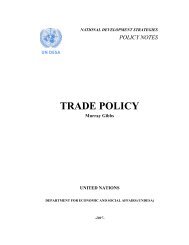SCP in Agriculture and Rural Development
SCP in Agriculture and Rural Development
SCP in Agriculture and Rural Development
Create successful ePaper yourself
Turn your PDF publications into a flip-book with our unique Google optimized e-Paper software.
It is thus important to create the <strong>in</strong>centives for producers to avert or reverse degradation by<br />
modify<strong>in</strong>g farm<strong>in</strong>g practices <strong>and</strong> undertak<strong>in</strong>g l<strong>and</strong> -improv<strong>in</strong>g <strong>in</strong>vestments on which long-term<br />
agricultural <strong>and</strong> rural development depend. Based on the lessons from past experience, the<br />
follow<strong>in</strong>g policies should be considered: (a) Increased utilization of environmentally friendly ways of<br />
pest control <strong>and</strong> fertilizer use (e.g. <strong>in</strong>tegrated production <strong>and</strong> pest management 5 ); (b) Improved<br />
water management to reduce soil sal<strong>in</strong>ization <strong>and</strong> erosion; (c) Industrial treatment of organic waste<br />
(e.g. manure waste from large poultry <strong>and</strong> livestock operations); (d) Dynamic monitor<strong>in</strong>g <strong>and</strong><br />
warn<strong>in</strong>g systems to track soil quality; <strong>and</strong> (e) Conservation agriculture, which targets the<br />
ma<strong>in</strong>tenance of permanent or semi-permanent soil coverage (through practices such as<br />
conservation tillage, use of cover crops, extensive crop rotations, <strong>and</strong> straw mulch<strong>in</strong>g) to reduce<br />
soil erosion. 6 Research shows that conservation agriculture produces net benefits for adopters <strong>in</strong><br />
both the developed <strong>and</strong> the develop<strong>in</strong>g world. 7<br />
In many cases, both technical <strong>and</strong> f<strong>in</strong>ancial support will be required to enable farmers to shift to<br />
more susta<strong>in</strong>able agricultural practices, especially the poorest. FAO is actively <strong>in</strong>volved <strong>in</strong><br />
promot<strong>in</strong>g conservation agriculture especially <strong>in</strong> develop<strong>in</strong>g <strong>and</strong> emerg<strong>in</strong>g economies. Integrated<br />
pest management (IPM) is notably be<strong>in</strong>g promoted through “farmer field schools”, a group-based<br />
learn<strong>in</strong>g process <strong>in</strong>itiated by FAO <strong>in</strong> 1989 <strong>in</strong> Indonesia to reduce farmer reliance on pesticides <strong>in</strong><br />
rice cultivation. Such programmes are now be<strong>in</strong>g conducted <strong>in</strong> over 30 countries worldwide. 8 More<br />
recently, a number of partnerships between bus<strong>in</strong>esses <strong>and</strong> NGOs <strong>and</strong> along supply cha<strong>in</strong>s have<br />
emerged, benefit<strong>in</strong>g both producers <strong>and</strong> the environment <strong>in</strong> the area of IPM (e.g. partnerships<br />
between the Wiscons<strong>in</strong> Potato <strong>and</strong> Vegetable Growers <strong>and</strong> the World Wildlife Fund, <strong>and</strong> between<br />
Sysco <strong>and</strong> its suppliers with third-party validation by the Wiscons<strong>in</strong> IPM Institute 9 ).<br />
At the same time, as global projections for water availability <strong>and</strong> the dem<strong>and</strong> for water <strong>in</strong><br />
agriculture po<strong>in</strong>t towards <strong>in</strong>creas<strong>in</strong>g scarcity <strong>and</strong> supply variability, more attention is be<strong>in</strong>g paid to<br />
the role that <strong>in</strong>novative policies can play <strong>in</strong> enhanc<strong>in</strong>g the efficient <strong>and</strong> susta<strong>in</strong>able management of<br />
water, <strong>in</strong> terms of both quantity <strong>and</strong> quality – <strong>in</strong>clud<strong>in</strong>g under the Integrated Water Resources<br />
Management (IWRM) concept. Institutional <strong>and</strong> market-based <strong>in</strong>struments must be comb<strong>in</strong>ed with<br />
promot<strong>in</strong>g dialogue between compet<strong>in</strong>g water users (farmers, municipalities, <strong>in</strong>dustry <strong>and</strong> eco-<br />
5 Integrated Pest Management (IPM) is a susta<strong>in</strong>able approach to manag<strong>in</strong>g pests by comb<strong>in</strong><strong>in</strong>g biological,<br />
cultural, physical <strong>and</strong> chemical tools <strong>in</strong> a way that m<strong>in</strong>imizes economic, health, <strong>and</strong> environmental risks.<br />
6 http://www.fao.org/ag/ca/<br />
7 Knowler, D. <strong>and</strong> B. Bradshaw (2007), “Farmers’ adoption of conservation agriculture: A review <strong>and</strong> synthesis of<br />
recent research”, Food Policy, 32, 25-48.<br />
8 Van der Berg, H. (2004), IPM Farmer Field Schools A synthesis of 25 impact evaluations Report prepared for the<br />
Global IPM facility (www.fao.org/docrep/006/ad487e/ad487e00.htm).<br />
9 Gunn<strong>in</strong>gham, N. 2007, “Incentives to improve farm management: EMS, supply-cha<strong>in</strong>s <strong>and</strong> civil society”, Journal<br />
of Environmental Management, 82, 302-310; <strong>and</strong> SYSCO: http://www.sysco.com/aboutus/aboutus_pestm.html.<br />
3 of 9
















